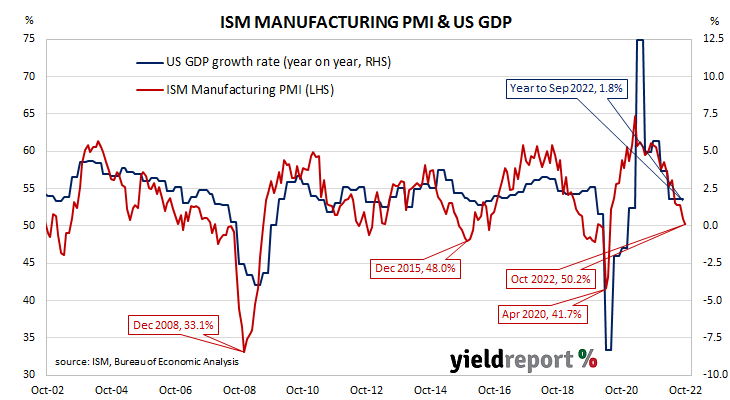Summary: ISM PMI down, at 50.9% in October, slightly above expectations; ISM: reading corresponds to 0.5% US GDP growth annualised.
The Institute of Supply Management (ISM) manufacturing Purchasing Managers Index (PMI) reached a cyclical peak in September 2017. It then started a downtrend which ended in March 2020 with a contraction in US manufacturing which lasted until June 2020. Subsequent month’s readings implied growth had resumed, with the index becoming stronger through to March 2021. Since then, readings have declined steadily.
According to the ISM’s October survey, its PMI recorded a reading of 50.2%, slightly above the generally expected figure of 50.0% but below September’s 50.9%. The average reading since 1948 is 53.0% and any reading above 50% implies an expansion in the US manufacturing sector relative to the previous month.
“The US manufacturing sector continues to expand, but at the lowest rate since the pandemic recovery began,” said Timothy Fiore, Chair of the ISM’s Manufacturing Business Survey Committee.
Short-term US Treasury yields finished the day noticeably higher while longer-term yields fell. By the close of business, the 2-year Treasury bond yield had gained 7bps to 4.55%, the 10-year yield had slipped 1bp to 4.04% while the 30-year yield finished 11bps lower at 4.09%.
In terms of US Fed policy, expectations of higher federal funds rates over the next 12 months hardened. At the close of business, November contracts implied an effective federal funds rate of 3.785%, 71bps higher than the current spot rate while December contracts implied a rate of 4.17%. November 2023 futures contracts implied 4.755%, 168bps above the spot rate.
Fiore noted “four straight months of panellists’ companies reporting softening new orders rates” and stated this represented “companies adjusting to potential future lower demand.”
Purchasing managers’ indices (PMIs) are economic indicators derived from monthly surveys of executives in private-sector companies. They are diffusion indices, which means a reading of 50% represents no change from the previous period, while a reading under 50% implies respondents reported a deterioration on average. A reading “above 48.7%, over a period of time, generally indicates an expansion of the overall economy” according to the ISM.
The ISM’s manufacturing PMI figures appear to lead US GDP by several months despite a considerable error in any given month. The chart below shows US GDP on a “year on year” basis (and not the BEA annualised basis) against US GDP implied by monthly PMI figures. .
According to the ISM and its analysis of past relationships between the PMI and US GDP, October’s PMI corresponds to an annualised growth rate of 0.5%, or 0.1% over a quarter. Regression analysis on a year-on-year basis suggests a 12-month GDP growth rate of 2.5% five months after this latest report.
The ISM index is one of two monthly US PMIs, the other being an index published by S&P Global. S&P Global produces a “flash” estimate in the last week of each month which comes out about a week before the ISM index is published. The S&P Global flash October manufacturing PMI registered 49.9%, 2.1 percentage points lower than September’s final figure.



